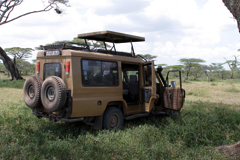
An enclosed vehicle with a pop up top is great
if you are a little nervous around dangerous
animals. Also if you happen to drive through a
localised heavy tsetse fly infestation then you
can drop the top and close the windows if you
are quick and avoid the worst of the little horrors.
Tsetse flies aren't present in many places and
sometimes then are only in low numbers so
check it out wherever you are heading for first
Giving a good bit of thought to your safari is essential if you want to get the best value out of the whole costly exercise.
I've been in Landcruisers with people who had no idea of what to expect to see or what living in a camp or even a safari lodge would be like.
Some I've talked to just should not have been there at all as a safari holiday was totally unsuited to them. People have been upset because there was no power for hairdryers, or no wifi or no fence round the camp. Some are upset because there are geckos in rooms and tents. Some have been totally unprepared clothes wise. The weather doesn't suit some. Guides have told me of ladies turning up in heels...the list goes on.
Many people have no real idea of what species of animal they are looking at. Kudu mistakenly named as wildebeeste, mongooses labeled as squirrels, and my personal pet hate, Cape buffalo referred to as water buffalo.
Job number one if you are planning a safari is to ask yourself what you would like to see. If it's tigers, then make sure you are headed for Asia. Some have asked to see tigers whilst in Africa.
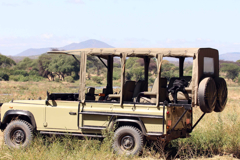
My personal preference is for the open sided
vehicle, with a sunroof. You get a great
unimpeded view of the wildlife, and feel that
little bit more connected in some way. You feel
the cool of the breeze more, and you get that
addtional frisson of excitement when a lion
strolls past about a metre away
Having compiled a list of must see (hopefully) and would like to see wildlife, then you need to start researching just where these animals are found. For instance if you really want to see a reticulated giraffe then your safari is limited to Kenya, north of the Tana river and Laikipia or possibly Ethiopia. If you want to see a red lechwe you are looking at Botswana's Okavango delta or bits of NW Zambia and Angola. Even wildebeeste aren't everywhere. In Tanzania they are present in Selous but not Ruaha. There are common waterbuck in Selous but defassa waterbuck in Ruaha. Read up on the ecology of the areas you are planning to visit, and the behaviour of the animals you are hoping to see.
You start to narrow locations down. You will be looking for a place where most of your targeted animals ranges overlap. At the same time. Don't forget some animals migrate and are only in an area for part of the year. This brings us to the next question of when to go. Not only is this dependant on the likelyhood of the species you are hoping to observe being present, but there is a further consideration of whether you prefer the wet or dry season, and the ramifications of the weather.
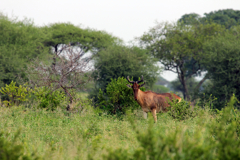
The season that you visit can make a big
difference to the ease of spotting game such
as this Coke's hartebeeste in Tarangire in
February. Also you have to decided if you want
to show the lush greenery of the rainy season
or the parched yellows and browns of the dry
season. Ideally you should go twice at different
times of the year, and yes we can all dream
Wet season can make travel difficult, and the lush greenery makes it hard to spot animals in bush country. Parts of the dry season in some countries can be too unbearably hot for some people to cope with. In places like Botswana, the night time temperatures can plummet to sub zero during parts of the year. You need to research climate and weather conditions for wherever you think you are going. We are lucky that we have the internet in this respect. There is a wealth of information available for most parks and areas of Africa. There are many videos (including mine) of peoples' trips which can give a good idea of what to expect, although it generally seems much better when you are there.
Once you narrow your choice down you can start to consider things like, accommodation, travel and the standard of guiding that you'd like.
There seem to be three types of accomodation. The first is you pack up a 4x4 with all your food, clothes, and camping gear and do a 'self drive' holiday. You stay in designated public campsites and do your own catering. You do your own spotting. This seems to be more common in southern Africa, which isn't surprising, as many residents do this sort of accomodation using their own vehicles. After all they are a lot more used to Africa and its ways than I am.
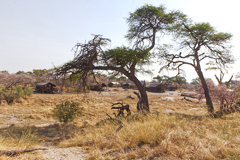
Camps out in the bush generally have a large
communal tent for meeting, socializing and
eating, and then well spaced out reasonably
private guest tents. Some have swimming
pools, which are very welcome in the heat of
the day. They don't have fences and there may
be guards on patrol overnight. Usually these
types of camp only cater for maybe twenty
guests max, but they lay on everything you
could possibly want. You also get interactions
with birds reptiles and mammals within their
confines so there is never a dull moment
The second is you stay in a campsite provided by a professional company, and you just turn up as a guest and they drive you about in their vehicles with their guides. They cook and make your bed. The level of luxury varies from fairly basic, with chemical loos and small tents with camp beds and not much else, although meals are still cooked, to large tents with comfy double beds and flushing loos and showers with hot water, and staff there to do your every bidding. This is often referred to as 'glamping', and is my favourite style by far.
The third is a proper lodge with a hotel type room, dining room, bar etc, all mod cons and probably air conditioning. You turn up in your vehicle with your driver guide and stay in the lap of luxury.
Whichever you choose, remember, the wildlife is exactly the same. Although in campsites you may get the chance to see wildlife right outside your tent, day or night. I've had a waterbuck standing within three feet of my head as I lay in bed one night and watched him through the flyscreen. Monkeys have played at bouncing off our tent canopy. We've had elephants walk past day and night and have found leopard tracks outside the tent. We've laid in bed listening to lions roaring as dawn breaks. If this sort of thing worries you then maybe a lodge is for you. Personally I'd recommend tented safari; you have a much more 'out in the bush' type of experience and are that bit more connected with nature.
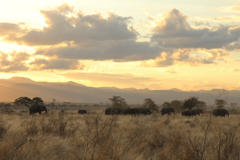
Meru in Kenya seems to have the best of both
worlds. Open savannah with hills in the
background and areas of thick bush and riverine
forests as well. The consequence of this a high
diversity of wildlife and the opportunity to get
creative with your photography. Traffic here is
very low
Consider the type of photography you are interested in. Are you happy with almost all close up shots of wildlife, with hardly any of the background featuring, or do you like to show more of the environment? More depth of field. More open vistas. Or are you happiest in thick bush with little consideration of the landscape and scenic value of the area. Maybe you could choose a wide open Serengeti type destination and to compliment it a more bush type stopover such as Selous.
Go online and look at possible camps and lodges. Take a big breath and be sitting down when you look at some of the prices. Choose your camp or camps to try and fit as much of your wishlist in as possible. If you choose more than one destination, then, for instance, one in a semi arid area and one in a subtropical area so as to get as much variation in species as possible, would be a good mix. Don't try and do too many locations. Too much time will be wasted travelling and you will never be able to relax. Time is at a premium on a safari (unless you are minted and can go for a month or two) and it should be used as far as possible for gamewatching and taking in the atmosphere of being in the wilds.
Book early. I usually book ten to twelve months in advance. I do this because a lot of the tented camps that I tend to favour are only small, with around five to ten guest tents, and so they soon fill up, especially if they have a good reputation or are located in a prime area.
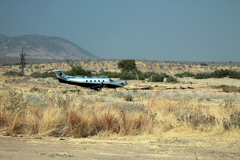
What arrangements do you need to make for
internal travel once you arrive at an international
airport? Are you being picked up by your driver,
or do you need to make a flight or two
to get to remote areas like Ruaha in Tanzania?
Internal flights on small aircraft are excellent for
looking down at the terrain and realizing just
how vast Africa is. And it's fun landing on bush
airstrips where somenone may need to move
game out of the way as you approach
Think about the environmental policy of your intended bases and how much of your money ends up in the local community. Do they have good ethical standards? Consider how much tourist traffic will be in the area. The Ngorongoro crater for instance is the best place in the world to see fleets of Landcruisers. If the thought of loads of other cars at a sighting puts you off then you are looking at less popular destinations such as Meru in Kenya where there's virtually no other traffic to be seen and you can have a lion sighting to yourself for hours if you want.
Travel. If arriving in country by air, check on times for possible connections. It may be sensible to have an overnight stay in a hotel before commencing the last leg of the journey. I met a couple once who flew into Tanzania on an overnight flight which was delayed, and then missed their morning connection from Dar es Salaam to Ruaha NP. It cost them a day's safari as they had no choice but to wait 24 hrs before the next day's aircraft.
Do you drive to the camp from your country arrival point or use an internal flight? For many remote sites flying by a small plane is the only sensible option unless you want the fun of the drive of course. Once on safari are you happy with a minibus or would you be ok in an open sided vehicle? You don't usually get the choice when you reach camp/lodge so check it out. I'd go for open sided Landcruiser type vehicles any day, although one that has the ability to fully close up was an adavantage once in a tsetse fly area.
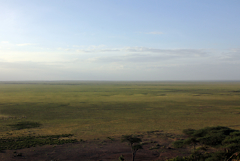
Should you crave the wide open spaces then
somewhere like the Serengeti is for you. Bear
in mind that traffic density will be a lot higher
than in the less visited parks, and you could
end up sharing your sightings, especially with
predators, with lots of other vehicles. Somehow
this spoils the moment for me. Sometimes you
have no choice though if you really want to see
an event like a Mara river crossing
Clothes can be an issue because of weight restrictions. Internal flights often have a 15kg limit, which includes your camera gear don't forget. I would research possible excess baggage fees. If only part of your holiday is safari then it's even more of a problem, unless you can leave regular holiday clothes somewhere. You don't need much for the safari bit. Look at minimum night time temperatures and decide if you need a jumper. Take a fleece anyway, you can wear it onto the plane if necessary so it's not part of your weight allowance. If you are being driven from the aiport then no worries. Check my safari tips page for what to pack.
Having done all that you can search for just the right place to stay. Look on my links page for some companies who I found useful in this respect. Once you've narrowed it down go on Tripadvisor and look at camp reviews.
Another thing to do is check all your photography gear over. Do you have all the bits and pieces, spare SD cards and batteries etc. Are the camera sensors in need of a clean? I had a hard time once because the contacts between my lens and camera were dirty and affected the autofocus quite badly. I lost a lot of shots till I realised what was happening. Hence I always carry a bottle of 'deoxit' with me.
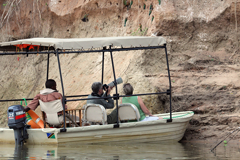
Boat trips are wonderful relaxing experiences
as you glide along, especially downstream with
the engine muted. You get a different way to see
animals, often close up and at a low camera
level which is great for photography. There are a
lot of different waterside birds that are most
easily photographed from a boat. Selous in
Tanzania is good for this
Think about what you are going to do with all your photos afterwards. Are there any 'must have' shots and what will you need to do to get them? Do you intend to highlight any particular aspects of your trip such as - camp life, the environment, trees and plants, poaching issues, the heat, drought, etc. If you fancy a crack at some night shots of the Milky Way then you could spend time on U tube finding out just what sort of camera settings you need.
Find out if there are any local laws you need to be aware of. For instance plastic bags are banned in some countries. And don't forget to get your jabs well in advance.
Planning will go a long way to ehancing the pleasure of your trip. It'd be a shame if you were disappointed by something that could have been easily avoided.